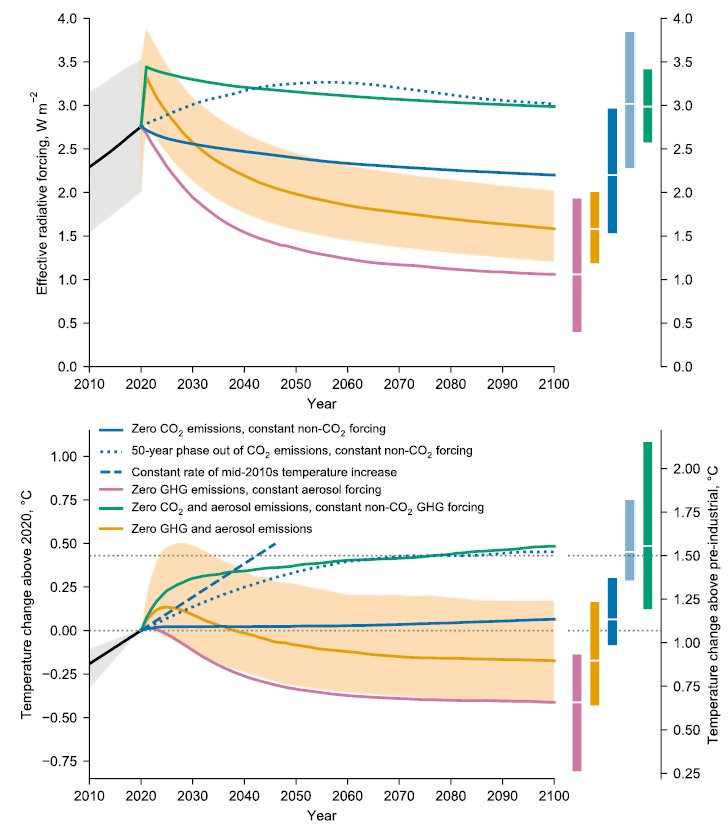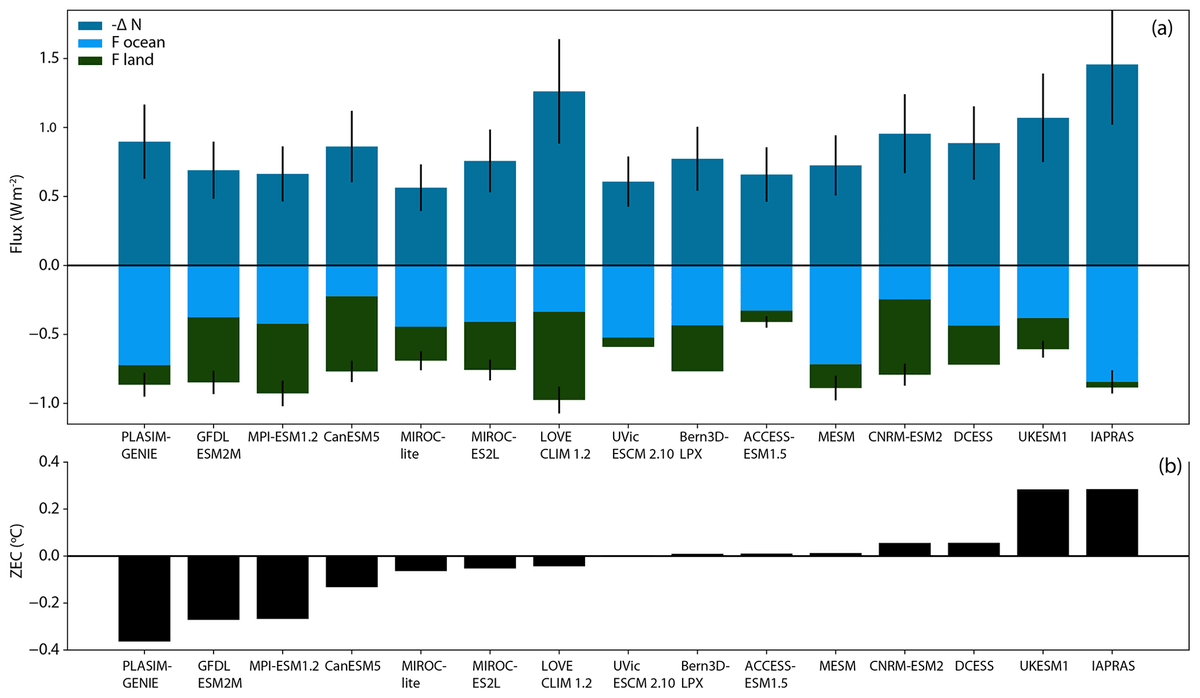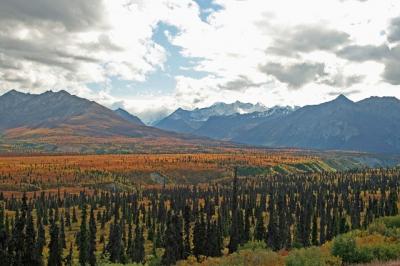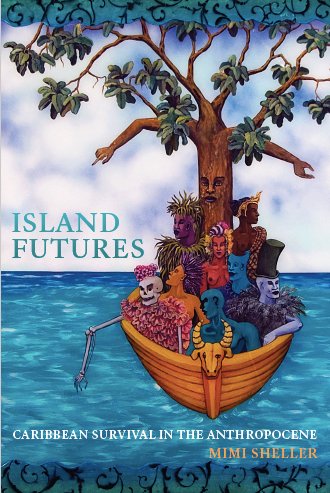Fascinating new paper by @AndrewDessler and colleagues arguing committed warming might be higher than expected given historical pattern effects. Its combining a lot of different concepts together, so lets spend some time disentangling them https://t.co/ILi5z515Qy
A thread: 1/19


More from Climate change
It was a dark and stormy night...
(I’ve always wanted to tweet that) But seriously, there was a tropical storm when a group of people gathered in the woods.
If they were white, we’d call them “founding fathers” but they were slaves who were about to change the world
A thread
Voudou priestess Cecile Fatiman danced with a knife. Then she split a pig and everyone drank the pig’s blood from a wooden bowl while enslaved priest Cutty Boukman prayed:
“The god who created the earth; who created the sun that gives us light. The god who holds up the ocean;
who makes the thunder roar. Our god who has ears to hear. You who are hidden in the clouds, who watch us from where you are. You see all that the white has made us suffer. The white man’s god asks him to commit crimes. But the god within us wants to do good...
It’s He who will direct our arms and bring us the victory. It’s He who will assist us. We all should throw away the image of the white men’s god who is so pitiless. Listen to the voice for liberty that speaks in all our hearts.”
Then , the meeting adjourned & everyone went home.
A week later, on Aug. 21 1791, it began.
In one week, 1800 plantations on the Island of St. Domingue would be burned to the ground and 1,000 white enslavers would be dead.
The shit had finally hit the fan.
(I’ve always wanted to tweet that) But seriously, there was a tropical storm when a group of people gathered in the woods.
If they were white, we’d call them “founding fathers” but they were slaves who were about to change the world
A thread
Holup. I ain't learned about this in school. What was this??
— Drunk Tweets, Inc - Mask it or Casket (@DrunkTweetsInc) January 1, 2021
Voudou priestess Cecile Fatiman danced with a knife. Then she split a pig and everyone drank the pig’s blood from a wooden bowl while enslaved priest Cutty Boukman prayed:
“The god who created the earth; who created the sun that gives us light. The god who holds up the ocean;
who makes the thunder roar. Our god who has ears to hear. You who are hidden in the clouds, who watch us from where you are. You see all that the white has made us suffer. The white man’s god asks him to commit crimes. But the god within us wants to do good...
It’s He who will direct our arms and bring us the victory. It’s He who will assist us. We all should throw away the image of the white men’s god who is so pitiless. Listen to the voice for liberty that speaks in all our hearts.”
Then , the meeting adjourned & everyone went home.
A week later, on Aug. 21 1791, it began.
In one week, 1800 plantations on the Island of St. Domingue would be burned to the ground and 1,000 white enslavers would be dead.
The shit had finally hit the fan.
The forests of Russia, Mongolia, Canada, Scandinavia and the US will experience unprecedented destructive heat by 2029 with staggering consequences for life on Earth.

Feedback loops created by permafrost melt & wildfire destruction represent just a few of the terrifying effects of climate change on boreal forest ecosystems, which are particularly at risk to rising temperatures. ⚠️🔥
https://t.co/zZNKrRnqoZ
Massive wildfires are already here.

More forest fires are burning in the Arctic in recent years than any time in the last 10,000 years.
🔺these massive arctic fires are showing worrying signs of becoming a vicious cycle
Wildfire-related carbon releases from permafrost regions will quadruple within decades.
Arctic wildfires, impacted by global warming, are in turn contributing to more climate breakdown.
🔺An increase in boreal & tundra fires in the future will enhance permafrost thawing.

Feedback loops created by permafrost melt & wildfire destruction represent just a few of the terrifying effects of climate change on boreal forest ecosystems, which are particularly at risk to rising temperatures. ⚠️🔥
https://t.co/zZNKrRnqoZ
Massive wildfires are already here.

More forest fires are burning in the Arctic in recent years than any time in the last 10,000 years.
🔺these massive arctic fires are showing worrying signs of becoming a vicious cycle
Wildfire-related carbon releases from permafrost regions will quadruple within decades.
Arctic wildfires, impacted by global warming, are in turn contributing to more climate breakdown.
🔺An increase in boreal & tundra fires in the future will enhance permafrost thawing.
1/ In reflecting on my work this year I have just realized that everything I published concerned climate change: here is a roundup of my 2020 writing on #climate #justice, climate #reparations, climate #debt, climate #displacement, climate #mobilities & #disaster #recovery
2/ My most recent online piece is on #Arctic #Mobilities, #climate #displacement and #Indigenous rights, originating from a great workshop @PennLaw_CERL
3/ Last month I also wrote about #climate #displacement and the case for #climate #reparations and #open #borders for those fleeing climate disasters
4/ Which originally appeared here
5/ Both of these came out of thinking about Caribbean #climate #colonialism and #climate #debt in my book Island Futures: Caribbean Survival in the Anthropocene @DukePress YOU CAN STILL GET IT for 50% off with the code E20SHELL https://t.co/i5DIaNAgsg

2/ My most recent online piece is on #Arctic #Mobilities, #climate #displacement and #Indigenous rights, originating from a great workshop @PennLaw_CERL
3/ Last month I also wrote about #climate #displacement and the case for #climate #reparations and #open #borders for those fleeing climate disasters
4/ Which originally appeared here
5/ Both of these came out of thinking about Caribbean #climate #colonialism and #climate #debt in my book Island Futures: Caribbean Survival in the Anthropocene @DukePress YOU CAN STILL GET IT for 50% off with the code E20SHELL https://t.co/i5DIaNAgsg

@smarzeli @ianrowley677 @chimera414 @BrknMan @ancistroneura @sueytonius @swcrisis @eloarefab @BailFund_Brawl @IngersolRobert @OscarsWild1 @RuleByLogic @KCTaz @Kenneth72712993 @alshalloway @ClimatePatriot @joetheatheistp @insane_voice @TheDisproof @Ceist8 @BradPKeyes @Fauntleroy1934 @DawnTJ90 @Jamz129 @JsharkJill @Tangomitteckel @joedieseldodge @BadgersNo @fknsavages27 @SimonPearson961 @JoeTheAtheist @CMorrisonEsq @maya_phd @CymaticWave @Schtickery @ClimateDepot @stevenmosher @Willard1951 @Tokyo_Tom @jc_Craze @DanCady @PolAnimalAus @ZombiePiano @SimonMaxfield8 @CrangusShish @Gladfly1 @AtomsksSanakan @leonardjcohen @FrankWi74044551 [1/14] It is very sad that @NatGeo is now publishing such disinformation. The article is lies.
The Earth is greening, thanks to elevated CO2 -- especially in arid
@ianrowley677 @chimera414 @BrknMan @ancistroneura @sueytonius @swcrisis @eloarefab @BailFund_Brawl @IngersolRobert @OscarsWild1 @RuleByLogic @KCTaz @Kenneth72712993 @alshalloway @ClimatePatriot @joetheatheistp @insane_voice @TheDisproof @Ceist8 @BradPKeyes @Fauntleroy1934 @DawnTJ90 @Jamz129 @JsharkJill @Tangomitteckel @joedieseldodge @BadgersNo @fknsavages27 @SimonPearson961 @JoeTheAtheist @CMorrisonEsq @maya_phd @CymaticWave @Schtickery @ClimateDepot @stevenmosher @Willard1951 @Tokyo_Tom @jc_Craze @DanCady @PolAnimalAus @ZombiePiano @SimonMaxfield8 @CrangusShish @Gladfly1 @AtomsksSanakan @leonardjcohen @FrankWi74044551 @NatGeo [2/14] NASA measures it, from
@ianrowley677 @chimera414 @BrknMan @ancistroneura @sueytonius @swcrisis @eloarefab @BailFund_Brawl @IngersolRobert @OscarsWild1 @RuleByLogic @KCTaz @Kenneth72712993 @alshalloway @ClimatePatriot @joetheatheistp @insane_voice @TheDisproof @Ceist8 @BradPKeyes @Fauntleroy1934 @DawnTJ90 @Jamz129 @JsharkJill @Tangomitteckel @joedieseldodge @BadgersNo @fknsavages27 @SimonPearson961 @JoeTheAtheist @CMorrisonEsq @maya_phd @CymaticWave @Schtickery @ClimateDepot @stevenmosher @Willard1951 @Tokyo_Tom @jc_Craze @DanCady @PolAnimalAus @ZombiePiano @SimonMaxfield8 @CrangusShish @Gladfly1 @AtomsksSanakan @leonardjcohen @FrankWi74044551 [3/14] @NatGeo used to be better. In 2009 they reported, "Vast swaths of North Africa are getting noticeably lusher due to warming temperatures, new satellite images show, suggesting a possible boon for people living in the driest part of the
@ianrowley677 @chimera414 @BrknMan @ancistroneura @sueytonius @swcrisis @eloarefab @BailFund_Brawl @IngersolRobert @OscarsWild1 @RuleByLogic @KCTaz @Kenneth72712993 @alshalloway @ClimatePatriot @joetheatheistp @insane_voice @TheDisproof @Ceist8 @BradPKeyes @Fauntleroy1934 @DawnTJ90 @Jamz129 @JsharkJill @Tangomitteckel @joedieseldodge @BadgersNo @fknsavages27 @SimonPearson961 @JoeTheAtheist @CMorrisonEsq @maya_phd @CymaticWave @Schtickery @ClimateDepot @stevenmosher @Willard1951 @Tokyo_Tom @jc_Craze @DanCady @PolAnimalAus @ZombiePiano @SimonMaxfield8 @CrangusShish @Gladfly1 @AtomsksSanakan @leonardjcohen @FrankWi74044551 [4/14] @NewScientist reported the "remarkable environmental turnaround," including a “quite spectacular regeneration of vegetation,” and "a 70 per cent increase in yields of local cereals such as sorghum and millet in one province in recent
@ianrowley677 @chimera414 @BrknMan @ancistroneura @sueytonius @swcrisis @eloarefab @BailFund_Brawl @IngersolRobert @OscarsWild1 @RuleByLogic @KCTaz @Kenneth72712993 @alshalloway @ClimatePatriot @joetheatheistp @insane_voice @TheDisproof @Ceist8 @BradPKeyes @Fauntleroy1934 @DawnTJ90 @Jamz129 @JsharkJill @Tangomitteckel @joedieseldodge @BadgersNo @fknsavages27 @SimonPearson961 @JoeTheAtheist @CMorrisonEsq @maya_phd @CymaticWave @Schtickery @ClimateDepot @stevenmosher @Willard1951 @Tokyo_Tom @jc_Craze @DanCady @PolAnimalAus @ZombiePiano @SimonMaxfield8 @CrangusShish @Gladfly1 @AtomsksSanakan @leonardjcohen @FrankWi74044551 @newscientist [5/14] Note that sorghum & millet are C4 plants. It was once thought that, unlike C3 plants, C4 plants would benefit little from rising CO2 levels. But C4 crops are favored for their drought-hardiness, &eCO2 is especially beneficial under dry
The Earth is greening, thanks to elevated CO2 -- especially in arid
@ianrowley677 @chimera414 @BrknMan @ancistroneura @sueytonius @swcrisis @eloarefab @BailFund_Brawl @IngersolRobert @OscarsWild1 @RuleByLogic @KCTaz @Kenneth72712993 @alshalloway @ClimatePatriot @joetheatheistp @insane_voice @TheDisproof @Ceist8 @BradPKeyes @Fauntleroy1934 @DawnTJ90 @Jamz129 @JsharkJill @Tangomitteckel @joedieseldodge @BadgersNo @fknsavages27 @SimonPearson961 @JoeTheAtheist @CMorrisonEsq @maya_phd @CymaticWave @Schtickery @ClimateDepot @stevenmosher @Willard1951 @Tokyo_Tom @jc_Craze @DanCady @PolAnimalAus @ZombiePiano @SimonMaxfield8 @CrangusShish @Gladfly1 @AtomsksSanakan @leonardjcohen @FrankWi74044551 @NatGeo [2/14] NASA measures it, from
@ianrowley677 @chimera414 @BrknMan @ancistroneura @sueytonius @swcrisis @eloarefab @BailFund_Brawl @IngersolRobert @OscarsWild1 @RuleByLogic @KCTaz @Kenneth72712993 @alshalloway @ClimatePatriot @joetheatheistp @insane_voice @TheDisproof @Ceist8 @BradPKeyes @Fauntleroy1934 @DawnTJ90 @Jamz129 @JsharkJill @Tangomitteckel @joedieseldodge @BadgersNo @fknsavages27 @SimonPearson961 @JoeTheAtheist @CMorrisonEsq @maya_phd @CymaticWave @Schtickery @ClimateDepot @stevenmosher @Willard1951 @Tokyo_Tom @jc_Craze @DanCady @PolAnimalAus @ZombiePiano @SimonMaxfield8 @CrangusShish @Gladfly1 @AtomsksSanakan @leonardjcohen @FrankWi74044551 [3/14] @NatGeo used to be better. In 2009 they reported, "Vast swaths of North Africa are getting noticeably lusher due to warming temperatures, new satellite images show, suggesting a possible boon for people living in the driest part of the
@ianrowley677 @chimera414 @BrknMan @ancistroneura @sueytonius @swcrisis @eloarefab @BailFund_Brawl @IngersolRobert @OscarsWild1 @RuleByLogic @KCTaz @Kenneth72712993 @alshalloway @ClimatePatriot @joetheatheistp @insane_voice @TheDisproof @Ceist8 @BradPKeyes @Fauntleroy1934 @DawnTJ90 @Jamz129 @JsharkJill @Tangomitteckel @joedieseldodge @BadgersNo @fknsavages27 @SimonPearson961 @JoeTheAtheist @CMorrisonEsq @maya_phd @CymaticWave @Schtickery @ClimateDepot @stevenmosher @Willard1951 @Tokyo_Tom @jc_Craze @DanCady @PolAnimalAus @ZombiePiano @SimonMaxfield8 @CrangusShish @Gladfly1 @AtomsksSanakan @leonardjcohen @FrankWi74044551 [4/14] @NewScientist reported the "remarkable environmental turnaround," including a “quite spectacular regeneration of vegetation,” and "a 70 per cent increase in yields of local cereals such as sorghum and millet in one province in recent
@ianrowley677 @chimera414 @BrknMan @ancistroneura @sueytonius @swcrisis @eloarefab @BailFund_Brawl @IngersolRobert @OscarsWild1 @RuleByLogic @KCTaz @Kenneth72712993 @alshalloway @ClimatePatriot @joetheatheistp @insane_voice @TheDisproof @Ceist8 @BradPKeyes @Fauntleroy1934 @DawnTJ90 @Jamz129 @JsharkJill @Tangomitteckel @joedieseldodge @BadgersNo @fknsavages27 @SimonPearson961 @JoeTheAtheist @CMorrisonEsq @maya_phd @CymaticWave @Schtickery @ClimateDepot @stevenmosher @Willard1951 @Tokyo_Tom @jc_Craze @DanCady @PolAnimalAus @ZombiePiano @SimonMaxfield8 @CrangusShish @Gladfly1 @AtomsksSanakan @leonardjcohen @FrankWi74044551 @newscientist [5/14] Note that sorghum & millet are C4 plants. It was once thought that, unlike C3 plants, C4 plants would benefit little from rising CO2 levels. But C4 crops are favored for their drought-hardiness, &eCO2 is especially beneficial under dry
Rising CO2 levels mitigate drought impacts. Elevated CO2 (eCO2) helps plants use water more efficiently, by improving CO2 stomatal conductance relative to transpiration. It's especially helpful in arid regions & during drought. Here's a paper about corn:https://t.co/lZ0wL4Gnvn
— Dave Burton \u274c (@ncdave4life) August 19, 2020



















